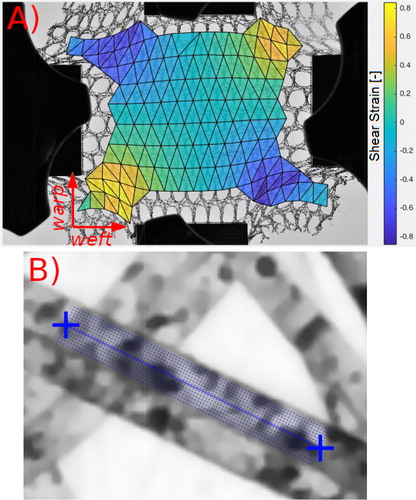1. Introduction
Abdominal wall hernia (AWH) is a protrusion of the abdominal cavity contents through a defect in the abdominal wall. AWH repair is one of the most common surgeries worldwide and the use of mesh has become standard of care. Despite tremendous progress in the treatment, complications remain with AWH repair and reported recurrence rates are still high (Andersen et al. Citation2009), and represent significant socio-economic burden.
These meshes have been extensively characterized at a global scale, assuming a continuous medium (Röhrnbauer and Mazza Citation2014). However, such approaches are not suited to apprehend failure modes, as these phenomena are initiated at yarn scale. Local observations pose significant experimental challenges, but are necessary to apprehend the mechanisms leading to failure by relating yarn stretch to global solicitations by the abdominal wall. In this study, knitted prosthetic mesh implants were loaded under biaxial tension, and for the first time the response at the global, meso and yarn scale was simultaneously characterized using an original approach.
2. Methods
2.1. Biaxial tensile tests
In an attempt to reproduce the physiological loading applied by intra-abdominal pressure, equibiaxial tensile tests were performed up to rupture on 7 knitted meshes cut in square sample of 50 × 50 mm2 at a quasi-static rate (0.1 N/s). A high-resolution camera (24MP with 90 mm macro lens) was setup with a field of view showing the entire specimen, and a high enough resolution so that individual yarns were visible. A speckle pattern was sprayed on the yarns using an airbrush. The specimen were backlit and frames were captured every 3 N.
2.1. Post-Processing
Post-processing was performed at 3 different scales.
Global scale. Assuming uniform and purely biaxial loading, tension-strain curves were obtained from the experiments.
Mesoscale. A mesoscale approach based on segmentation and triangulation of each pore of the mesh allowed a displacement and strain field measure at this scale ().
Yarn scale. Finally, local tracking of the speckle pattern on the yarns using digital image correlation allowed local stretch measurements for straight segments of individual yarns (). Five key straight yarns of the unit structure were analysed at different locations in the mesh (central area, near the clamps and in the corners).
3. Results and discussion
The meshes exhibited non-linear, anisotropic behaviour, as seen in . Peak tension values reached 2.5 ± 0.3 N/mm. Failure strain averaged 28 ± 3% along weft direction and 8.5 ± 2% along warp direction.
Figure 1. Equibiaxial tensile response in warp and weft directions up to rupture for the 7 specimen.

At the mesoscale, strain fields were largely non-uniform, with almost uniaxial strain near the clamps, and large shear strains at the corners (), due to the clamping of the specimen preventing a pure biaxial strain field.
At the yarn scale, lower fiber strains were observed, ranging from 0 to 8%, with the largest values concerning only a few specific yarns, mainly close to the clamps.
The difference in terms of strain magnitudes among the different scales was obvious; for instance, near the clamps in the warp direction, maximum local fiber strains were typically 4–6%, while mesoscale strain was 12–18% and global strain 8%.
The mesoscale strain fields clearly show that the assumption of uniform, purely biaxial strain could potentially lead to erroneous results when fitting constitutive data using clamp displacement and global force as measures for strain and tension. Such non-uniform fields dictate the need for inverse identification methods.
Yarn scale results show that strains did not distribute evenly among the yarns, indicating that some of them may take a majority of the load while others are barely stretched. It highlights the complex behaviour of such structures, suggesting a strong reordering of the network under load, as observed through large loop slidings.
4. Conclusions
This approach provides promising results to better understand how the load is transferred from the abdominal wall to individual yarns, depending on the microstructure (knitting pattern). It is the first step towards the design of optimized meshes specifically adapted to their mechanical environment to better accommodate human physiology.
Disclosure statement
No potential conflict of interest was reported by the authors.
References
- Andersen L, Klein M, Gögenur I, Rosenberg J. 2009. Long-term recurrence and complication rates after incisional hernia repair with the open onlay technique. BMC Surg. 9:6.
- Röhrnbauer B, Mazza E. 2014. Uniaxial and biaxial mechanical characterization of a prosthetic mesh at different length scales. J Mech Behav Biomed Mater. 29:7–19.

